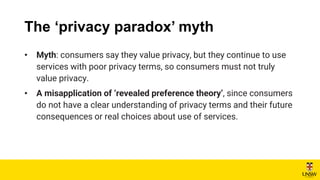The Intersection between Competition and Data Privacy тАУ KEMP тАУ June 2024 OECD discussion
- 1. The Intersection Between Competition and Data Privacy Assoc Professor Katharine Kemp, Faculty of Law & Justice, UNSW Sydney OECD Roundtable, June 2024
- 2. The тАШsubjective preferenceтАЩ myth тАв Myth: privacy is just a тАШsubjective preferenceтАЩ. A minority of consumers value privacy, but most donтАЩt, so consumers should just make their own choices. тАв Privacy degradation is an objective cost imposed on consumers: increases the attack surface of data for breaches and misuse; increases the risk of identity crimes, scams, fraud, discrimination, exclusion, manipulation and humiliation.
- 3. The тАШprivacy paradoxтАЩ myth тАв Myth: consumers say they value privacy, but they continue to use services with poor privacy terms, so consumers must not truly value privacy. тАв A misapplication of тАШrevealed preference theoryтАЩ, since consumers do not have a clear understanding of privacy terms and their future consequences or real choices about use of services.
- 4. The тАШdemocratizing dataтАЩ myth тАв Myth: the solution is to тАШdemocratize the dataтАЩ so that all firms have access to the data, creating a level playing field. тАв Inappropriate for personal data. We should not тАШdemocratizeтАЩ personal data any more than we should democratize kidneys. тАв Na├пve to argue that data can simply be anonymized. Ongoing re- identification risks, plus truly anonymized data does not level playing fields.
- 5. тАШConcealed data practicesтАЩ тАв тАЬOccur when suppliersтАЩ terms provide weak privacy protections for consumers while the extent of those terms, the resultant data practices and the consequences of these data practices are concealed from consumers.тАЭ тАв тАЬPermit the collection, retention, use and/or disclosure of personal information, beyond that which is necessary for the provision of the service in question and beyond the reasonable expectations of the consumer.тАЭ Kemp, тАЬConcealed Data PracticesтАЭ (2020) European Competition Journal
- 6. CDPs undermine competitive process тАв Decrease privacy quality / raise quality-adjusted price. тАв Aid in creating and extending market power by means other than superior efficiency. тАв Make it unlikely markets will self-correct, especially in digital markets with network effects and economies of scope from data. тАв Hinder privacy-enhancing rivals since nature and extent of harms from concealed data practices are hidden. тАв Exacerbate the effects of exclusionary conduct. Kemp, тАЬConcealed Data PracticesтАЭ (2020) European Competition Journal
- 7. The perils of the regulatory relay in data privacy ┬й Reuters: Dylan Martinez
- 8. Lessons from Google / Double Click тАЬ[W]hy would Google pay billions of dollars for DoubleClick, in an effort to keep DoubleClick out of the hands of competitors, if Google does not intend to combine the two firmsтАЩ valuable datasets?тАЭ In the matter of Google/DoubleClick F.T.C. (2007) Dissenting Statement, Commissioner Pamela Jones Harbour
- 9. Lessons from Google / Double Click тАв 2007: Google stated it did not plan to combine the firmsтАЩ datasets. тАв 2007: FTC majority decided not to impose data / privacy conditions on the merger. Left to privacy enforcement. тАв GoogleтАЩs post-merger privacy policy stated, тАЬWe will not combine DoubleClick cookie information with personally identifiable information unless we have your opt-in consent.тАЭ тАв 2016: Google deleted this promise from its privacy policy.
- 10. Lessons from Google / Double Click тАв Google then spent substantial time and resources designing тАЬa тАШConsent BumpтАЩ that would make it more likely that users would тАШclickтАЩ on the option to agreeтАЭ to the datasets being combined. тАв In the process, Google removed all references to тАЬprivacyтАЭ from the consent request and titled it тАЬSome new features for your accountтАЭ. тАв 2022: Federal Court of Australia held GoogleтАЩs тАШConsent BumpтАЩ was not misleading.
- 11. Level playing field of compliance vs lawless data grab
- 12. Need for early data protection enforcement тАв Unsanctioned data protection breaches can create first mover / incumbent advantages тАУ eg, AI foundation models. тАв Rivals expect to follow suit. тАв Meta: тАЬWe are confident that our approach complies with privacy laws, and our approach is consistent with how other tech companies are developing and improving their AI experiences in Europe (including Google and Open AI)тАЭ.
- 13. Difficulties in legal transplants тАв Bundeskartellamt (Meta) approach: recognise exploitative abuses; some jurisdictions only recognise exclusionary. тАв US FTC approach: the same agency can pursue competition and consumer privacy actions; consumer protection is not equivalent to privacy as a fundamental right.
- 14. Privacy justifications for monopolization, or de facto privacy regulators
- 15. Testing privacy justifications тАв тАШInternal data free-for-allтАЩ vs restrictions on rivalsтАЩ use of data. тАв Dominant firmтАЩs internal combination of data and failure of purpose limitation may preference own data practices. тАв The objective should be data protection compliance by all. тАв Difficulty where genuine increase in competition on privacy quality occurs in different market to restriction on competition.








![Lessons from Google / Double Click
тАЬ[W]hy would Google pay billions of dollars for DoubleClick, in an
effort to keep DoubleClick out of the hands of competitors, if
Google does not intend to combine the two firmsтАЩ valuable
datasets?тАЭ
In the matter of Google/DoubleClick F.T.C. (2007)
Dissenting Statement, Commissioner Pamela Jones Harbour](https://image.slidesharecdn.com/oecd-data-and-privacy-kemp-june2024-240614123904-191d4d1b/85/The-Intersection-between-Competition-and-Data-Privacy-KEMP-June-2024-OECD-discussion-8-320.jpg)






